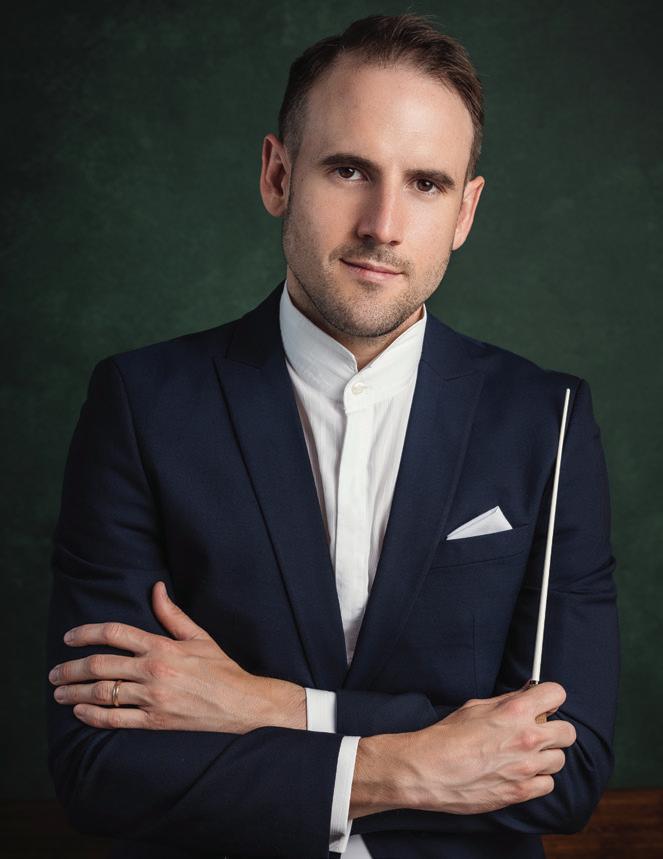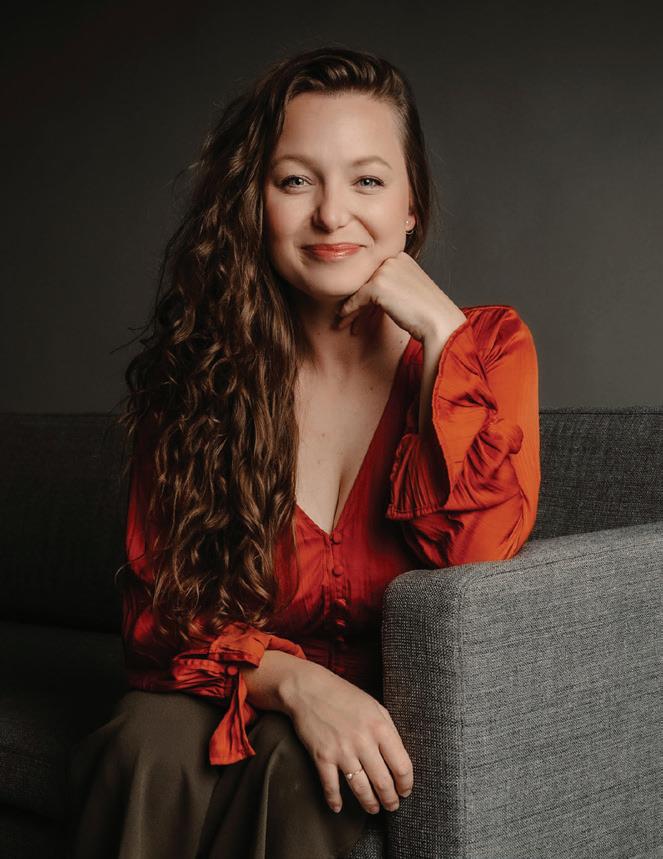SYMPHONY NO. 1
WEDNESDAY, JULY 30, 2025 / 8:00 PM / ST. MARY’S CATHOLIC CHURCH
FRANÇOIS LÓPEZ-FERRER, conductor
MADISON LEONARD, soprano UTAH SYMPHONY
ARVO PÄRT
MOZART
MOZART
MOZART
MOZART
Wenn Bach Bienen gezüchtet hätte...
(If Bach Had Been a Beekeeper...) (7’)
“Ruhe sanft, mein holdes Leben” from Zaide (7’)
“Ach, ich liebte, war so glücklich” from The Abduction from the Seraglio (5’)
“Al desio, di chi t’adora” (6’)
“Vado, ma dove?” (4’)
INTERMISSION

BEETHOVEN
Symphony No. 1 (25’)
I. Adagio molto - Allegro con brio
II. Andante cantabile con moto
III. Menuetto: Allegro molto e vivace
IV. Finale: Adagio - Allegro molto e vivace

François López-Ferrer
Conductor
Spanish-American conductor François López-Ferrer has carved an impressive path in the world of classical music, distinguished by his dynamic artistry and compelling performances. Recipient of the prestigious 2024 Sir Georg Solti Conducting Award, his international career has been marked by recent debuts with esteemed orchestras worldwide, including the Chicago Symphony Orchestra, Los Angeles Philharmonic (LA Phil) at the Hollywood Bowl, Hong Kong Philharmonic, Opéra national de Paris, Detroit Symphony Orchestra, Orquesta Nacional de España, Orquesta Sinfónica de Galicia, Orquesta Sinfónica Radio Televisión Española, Verbier Festival Orchestra, Ensemble intercontemporain, Opéra de Lausanne, and George Enescu Philharmonic.
Upcoming engagements include debuts with the Orquesta Sinfónica de Madrid at the Teatro Real de Madrid in a production of Verdi’s Il Trovatore, Houston and Utah Symphonies, Orchestra Sinfonica G. Rossini at the Rossini Opera Festival, Basque National Orchestra, Biel Solothurn Symphony Orchestra, and the Spoleto Festival USA leading Britten’s Turn of the Screw, as well as returns to the Omaha Symphony, Rochester Philharmonic, Orquesta Sinfónica de Castilla y León, Orquesta Sinfónica de Puerto Rico, and the Symphony San Jose.

Madison Leonard Soprano
Praised for her “silvery, ethereal-sounding Sophie” by Opera magazine and “lovely vocal delicacy” in The Telegraph, Madison Leonard has previously sung Eurydice in Orfeo ed Eurydice (Dallas Opera) and Adina in L’elisir d’amore (Garsington Opera) as well as Mahler’s Symphony No. 2 (Los Angeles Master Chorale) in the 2024–25 season.

Her performance of Gilda in Rigoletto with Austin Opera was named one of the Top Ten Joys in Dance and Classical Music by the Austin Chronicle, and she has returned as Leïla in Les pêcheurs des perles and Chrisann Brennan in Bates’ The [R]evolution of Steve Jobs. She has made role debuts with Garsington Opera (Sophie in Der Rosenkavalier, Giulietta di Kelbar in Un giorno di regno) and Seattle Opera (Gilda in Rigoletto, Chrisann Brennan in The [R]evolution of Steve Jobs, Adina in L’elisir d’amore). She has also sung Gilda in Rigoletto (Dallas Opera); Juliette in Roméo et Juliette (Central City Opera); Marie in La fille du régiment, Susanna in Le nozze di Figaro and Mabel in The Pirates of Penzance (Utah Opera); Musetta in La bohème (Dallas Opera); Despina in Così fan tutte (Palm Beach Opera); and Morgana in Alcina, and the Rose in The Little Prince (Washington National Opera).
Her concert appearances include engagements with the National Symphony Orchestra, Florida Orchestra, and Fort Worth Symphony Orchestra.
By Ruth Eldredge
Wenn Bach Bienen gezüchtet hätte…
// Flute, oboe, clarinet, bassoon, horn, percussion, piano, and strings //
The History
Estonian composer Arvo Pärt’s music often sounds familiar, even on the first hearing. Its diatonic harmonies, memorable, often slow-paced, melodies, and heart-beat paced rhythms ground his music in humanism and tradition, even though his techniques are decidedly conceptual and avant-garde. Originally written in 1976, Wenn Bach Bienen gezüchtet hätte...(If Bach Had Been a Beekeeper...) combines Pärt’s innovative and bracingly modernist tintinnabula style with time-honored musical ideas. The most recognizable parts of Pärt’s tintinnabula (Latin for ‘a ringing bell’) style are two main voices. The first is a slow melody that, in this piece and across all of Pärt’s music, usually proceeds in stepwise motion, up or down by one note at a time. In this piece it often sounds like pieces of a major scale.
himself. The aria’s relatively simple melody masks the aria’s technical demands, itself a metaphor for the hidden trials of true love.
“Ach, ich liebte, war so glücklich”
// Soprano solo, 2 oboes, 2 clarinets, 2 bassoons, 2 horns and strings //
“Alas I loved, so happily” is one of the signature arias from Mozart’s hit 1781 opera The Abduction from the Seraglio. The aria, sung by Constanze, laments her separation from her betrothed Belmonte, who has sworn to rescue her from being abducted by Turkish pirates. Mozart’s decision to name the prima donna character after Constanze Weber— whom he married two weeks after the opera’s premiere— underscored their romance and his promise of constant fidelity to his wife, uncommon in an era where extramarital affairs were an open secret.
“Al desio, di chi t’adora”
// Soprano solo, clarinet, bass clarinet, 2 bassoons, 2 horns and strings //

The second voice represents the ringing bell itself. Pärt usually creates this effect by writing fast arpeggios up and down, creating an ethereal effect, like the sonic version of watching a spinning top or light glistening on a field of snow. Pärt normally uses fast-repeating arpeggios to create this effect, but in this piece, he uses the notes B flat, A, C, and B natural, which in German are written B-A-C-H. Unsurprisingly, Johann Sebastian Bach himself discovered this sequence of notes and used it in several preludes and fugues. In the three and a half centuries since Bach’s death, many composers have paid their debt to his genius by using the same ‘Bach’ theme in their own music. Here, Pärt turns it into a fast-moving cross between melody, accompaniment, and sound effect—the effect is of a dissonant, and surprisingly convincing, sound of swarming bees.
“Ruhe sanft, mein holdes Leben”
// Soprano solo, oboe, bassoon and strings //
“Rest gently, my dearest Life” is taken from Mozart’s unfinished opera Zaide. Had Mozart finished and produced the opera, this would surely have been a high point: Zaide, a heroine slave, finds her beloved Gomatz asleep and confesses her love, then leaves a portrait of herself on his pillow. Like any good opera, their love is thwarted, this time by Zaide’s master who is determined to have her for
Mozart wrote “[Come, fly,] to the desire of [the one] who adores you” as an alternative aria to Susanna’s moreused “Deh vieni”, during Act IV of The Marriage of Figaro Susanna, a servant has found herself in an awkward situation in which she is disguised as the Countess and pretends to sing a love song to the Count, while her fiancé Figaro, watches on from behind a bush. Unusual for its conspicuous use of wind instruments, and memorable for its multi-layered antics and hilarious scene, the aria celebrates Susanna’s ability to manipulate her master and mistress, even while convincing them that they are in charge.
“Vado, ma dove?”
// Soprano solo, 2 clarinets, 2 bassoons, 2 horns and strings //
Like the previous arias, Mozart wrote “Vado, ma dove?” (“I am going, but where?”) as an insert aria, but this time for a friend: Mozart wrote this aria to appear in an opera by Spanish composer Martín y Soler. Since then, the aria has lived on as a concert piece and as an insertion to many other operas of many other composers—a testament to the flexibility of the operatic form and the prima donna’s privilege to show off. Today, the aria is most often heard as a standalone piece, or as an insertion to Mozart’s own Così fan tutte

HISTORY OF THE MUSIC — SYMPHONY NO. 1
Symphony No. 1
// 2 flutes, 2 oboes, 2 clarinets, 2 bassoons, 2 horns, 2 trumpets, timpani and strings //
Beethoven had fully intended to study with Mozart but never had the chance—Beethoven had travelled to Vienna in 1787 but was called home to care for his siblings after his mother’s death. Beethoven was just 16 years old. By the time he returned to Vienna in 1792, Mozart himself had died and Beethoven began studying with Haydn. He once proclaimed that he had “never learned anything from Haydn,” but his music tells a different story.
Premiered in 1800 in Vienna, Beethoven ensured that his symphony appeared as the closing piece on a concert otherwise full of Haydn and Mozart’s music. Beethoven also wrote the symphony to show off what he knew of Haydn and Mozart—and how he had surpassed them. Whether or not the audience bought his message of greatness, they got a taste for his intentions to revolutionize the symphony into a much larger, more emotionally expressive, musical experience.
Symphony No. 1 stands out from Beethoven’s other eight symphonies for its humor and cheerfulness, even while it foreshadows melodic and harmonic intensity, even brooding, that are most often associated with Beethoven’s musical voice. The first movement is an overt homage to Mozart’s 41st (and last known) symphony, written just a few years earlier: both are written in the key of C major
and begin with a minute-long slow introduction, and they both switch between the trumpet-and-drum optimism of C major, and the more pensive C minor. Beethoven also alludes to Mozart’s symphony in his melodic and harmonic structuring. Listen for a four-note upward flourish, repeated several times, in the violin section, an allusion to a similar element in Mozart’s 41st symphony. More esoterically, Beethoven also borrows an unusual backward circle-offifths harmonic progression in this movement.
The second movement underscores the humorous nature of the classical symphony. Though Beethoven tended to become very serious in the second movements of his piano sonatas, this one has little hint of brooding. Indeed, the second and third movements hide a musical insider’s joke: the second movement is called andante, and built like a minuet—in stately 3/4 time, with highly ordered phrase lengths and harmonic structures. Meanwhile, the third movement, which his listeners would have expected to be a minuet, is actually a scherzo. Scherzo literally means ‘a joke’ and this one is certainly that: though it’s also in 3/4 time, a scherzo is much faster and veers from playful to ominous and back again, all in just a few minutes of music.
The fourth movement is often considered one of Beethoven’s masterpieces of wit. It also proves that, at least at some point in his life, he had a sense of humor. The movement begins, unusually, with a slow introduction in which the violins try to play a full major scale, but fail several times. They finally succeed in reaching the final note just as the tempo speeds up.

